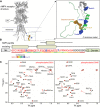Regulation of GluA1 α-amino-3-hydroxy-5-methyl-4-isoxazolepropionic acid receptor function by protein kinase C at serine-818 and threonine-840
- PMID: 24452473
- PMCID: PMC4014661
- DOI: 10.1124/mol.113.091488
Regulation of GluA1 α-amino-3-hydroxy-5-methyl-4-isoxazolepropionic acid receptor function by protein kinase C at serine-818 and threonine-840
Abstract
Three residues within the AMPA (α-amino-3-hydroxy-5-methyl-4-isoxazolepropionic acid) receptor subunit GluA1 C terminus (Ser818, Ser831, Thr840) can be phosphorylated by Ca(2+)/phospholipid-dependent protein kinase (PKC). Here, we show that PKC phosphorylation of GluA1 Ser818 or Thr840 enhances the weighted mean channel conductance without altering the response time course or agonist potency. These data support the idea that these residues constitute a hyper-regulatory domain for the AMPA receptor. Introduction of phosphomimetic mutations increases conductance only at these three sites within the proximal C terminus, consistent with a structural model with a flexible linker connecting the distal C-terminal domain to the more proximal domain containing a helix bracketed by Ser831 and Thr840. NMR spectra support this model and raise the possibility that phosphorylation can alter the configuration of this domain. Our findings provide insight into the structure and function of the C-terminal domain of GluA1, which controls AMPA receptor function and trafficking during synaptic plasticity in the central nervous system.
Figures





 where ΔN is the difference in the nitrogen shift and ΔHN is the shift in the nitrogen proton.
where ΔN is the difference in the nitrogen shift and ΔHN is the shift in the nitrogen proton.Similar articles
-
Inhibitory interactions between phosphorylation sites in the C terminus of α-Amino-3-hydroxy-5-methyl-4-isoxazolepropionic acid-type glutamate receptor GluA1 subunits.J Biol Chem. 2014 May 23;289(21):14600-11. doi: 10.1074/jbc.M114.553537. Epub 2014 Apr 4. J Biol Chem. 2014. PMID: 24706758 Free PMC article.
-
PKC phosphorylates GluA1-Ser831 to enhance AMPA receptor conductance.Channels (Austin). 2012 Jan-Feb;6(1):60-4. doi: 10.4161/chan.18648. Epub 2012 Jan 1. Channels (Austin). 2012. PMID: 22373567 Free PMC article.
-
Mechanism of Ca2+/calmodulin-dependent kinase II regulation of AMPA receptor gating.Nat Neurosci. 2011 Jun;14(6):727-35. doi: 10.1038/nn.2804. Epub 2011 Apr 24. Nat Neurosci. 2011. PMID: 21516102 Free PMC article.
-
Preferential generation of Ca2+-permeable AMPA receptors by AKAP79-anchored protein kinase C proceeds via GluA1 subunit phosphorylation at Ser-831.J Biol Chem. 2019 Apr 5;294(14):5521-5535. doi: 10.1074/jbc.RA118.004340. Epub 2019 Feb 8. J Biol Chem. 2019. PMID: 30737285 Free PMC article.
-
Dynamic increases in AMPA receptor phosphorylation in the rat hippocampus in response to amphetamine.J Neurochem. 2015 Jun;133(6):795-805. doi: 10.1111/jnc.13067. Epub 2015 Mar 2. J Neurochem. 2015. PMID: 25689263 Free PMC article.
Cited by
-
Dopamine receptors - IUPHAR Review 13.Br J Pharmacol. 2015 Jan;172(1):1-23. doi: 10.1111/bph.12906. Br J Pharmacol. 2015. PMID: 25671228 Free PMC article. Review.
-
Glutamatergic Tuning of Hyperactive Striatal Projection Neurons Controls the Motor Response to Dopamine Replacement in Parkinsonian Primates.Cell Rep. 2018 Jan 23;22(4):941-952. doi: 10.1016/j.celrep.2017.12.095. Epub 2018 Jan 28. Cell Rep. 2018. PMID: 29386136 Free PMC article.
-
Inhibitory interactions between phosphorylation sites in the C terminus of α-Amino-3-hydroxy-5-methyl-4-isoxazolepropionic acid-type glutamate receptor GluA1 subunits.J Biol Chem. 2014 May 23;289(21):14600-11. doi: 10.1074/jbc.M114.553537. Epub 2014 Apr 4. J Biol Chem. 2014. PMID: 24706758 Free PMC article.
-
The AMPA Receptor Code of Synaptic Plasticity.Neuron. 2018 Oct 24;100(2):314-329. doi: 10.1016/j.neuron.2018.10.018. Neuron. 2018. PMID: 30359599 Free PMC article. Review.
-
β-Adrenergic receptor signaling and modulation of long-term potentiation in the mammalian hippocampus.Learn Mem. 2015 Aug 18;22(9):461-71. doi: 10.1101/lm.031088.113. Print 2015 Sep. Learn Mem. 2015. PMID: 26286656 Free PMC article. Review.
References
-
- Barria A, Derkach V, Soderling T. (1997a) Identification of the Ca2+/calmodulin-dependent protein kinase II regulatory phosphorylation site in the α-amino-3-hydroxyl-5-methyl-4-isoxazole-propionate-type glutamate receptor. J Biol Chem 272:32727–32730 - PubMed
-
- Barria A, Muller D, Derkach V, Griffith LC, Soderling TR. (1997b) Regulatory phosphorylation of AMPA-type glutamate receptors by CaM-KII during long-term potentiation. Science 276:2042–2045 - PubMed
-
- Benke TA, Lüthi A, Isaac JT, Collingridge GL. (1998) Modulation of AMPA receptor unitary conductance by synaptic activity. Nature 393:793–797 - PubMed
-
- Bliss TV, Collingridge GL. (1993) A synaptic model of memory: long-term potentiation in the hippocampus. Nature 361:31–39 - PubMed
MeSH terms
Substances
Grants and funding
LinkOut - more resources
Full Text Sources
Other Literature Sources
Miscellaneous

